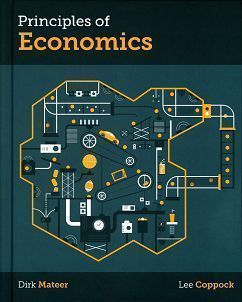書籍分類

Principles of Economics
作者:Dirk Mateer, Lee Coppock
原價:NT$ 1,350
ISBN:9780393283365
版次:1
年份:2014
出版商:W. W. Norton & Co.
頁數/規格:1156頁/精裝彩色
版次:1
年份:2014
出版商:W. W. Norton & Co.
頁數/規格:1156頁/精裝彩色
內容介紹 本書特色 目錄 作者介紹
- Description
Makes economics stick. Meets students where they are.
Two innovative instructors use their tested insights and successful teaching practices to create a truly student-centered approach: real-world examples, pedagogy developed in their own classrooms, and problem solving tools that resonate with today’s students.
- Features
-
A FRAMEWORK THAT HELPS STUDENTS RELATE ECONOMICS TO THEIR OWN LIVES
Principles of Economics uses examples that meet students where they are. Economics in the Real World examples connect the narrative to current events. Economics in the Media boxes in every chapter illuminate how economics informs popular culture. And Economics for Life boxes show how economics impacts students personally.
-
TEACHES PROBLEM SOLVING SKILLS
Practice What You Know boxes allow students to self-assess and check their understanding as soon as they finish learning about a topic. Theses boxes are framed within everyday situations, illuminating how the concepts relate to students’ lives. Two completely solved problems at the end of every chapter reinforce important chapter concepts and help students develop the problem solving skills they’ll need on exams.
-
AN ENGAGING AND PERSONAL PATH TO LEARNING
Each chapter begins with Big Questions that focus student attention on the most important chapter topics. The Answering the Big Questions feature at the end of the chapter returns to these questions and reinforces the important take-home messages. Snapshot infographics in each chapter highlight a key chapter topic, reinforcing important chapter takeaways for students. These engaging and highly visual spreads include review questions that get students thinking about the illustrated concept and connect the graphic to key chapter content. In addition, Office Hours Video Tutorials (filmed with and conceived by the authors) explain fundamental concepts focusing on topics that are typically difficult to explain in writing—such as shifting supply and demand curves. Office Hours videos have been incorporated throughout Norton SmartWork as video feedback for questions, integrated into the ebook, and included in the coursepack.
-
NORTON SMARTWORK: A COMPLETE LEARNING ENVIRONMENT AND ONLINE COURSE
Norton SmartWork delivers a suite of innovative tutorials, learning tools, and assessment in a pedagogically effective way. Solution feedback and answer-specific feedback help students become better problem solvers, not just solve a single problem. Norton Guided Personalized Study Tutorials(Norton GPS), structured around each chapter’s Big Questions, help students identify chapter objectives they need to work on and lead students down personalized review paths based on their existing level of understanding. And Interactive Scratch Paper Tutorials help students better understand cause and effect in economics. Based on the foundational graphs of economics, these 10 tutorial modules encourage students to experiment with moving different curves and help students see how changes in one curve can affect other variables like price.
- Table of Contents
Part I Introduction
1. The Five Foundations of Economics
2. Model Building and Gains from Trade
Part II The Role of Markets
3. The Market at Work: Supply and Demand
4. Elasticity
5. Price Controls
6. The Efficiency of Markets and the Costs of Taxation
7. Market Inefficiencies: Externalities and Public Goods
Part III The Theory of the Firm
8. Business Costs and Production
9. Firms in a Competitive Market
10. Understanding Monopoly
11. Price Discrimination
12. Monopolistic Competition and Advertising
13. Oligopoly and Strategic Behavior
Part VI Labor Markets and Earnings
14. The Demand and Supply of Resources
15. Income, Inequality, and Poverty
Part V Special Topics in Microeconomics
16. Consumer Choice
17. Behavioral Economics and Risk Taking
18. Health Insurance and Health Care
Part VI Macroeconomic Basics
19. International to Macroeconomics and Gross Domestic Product
20. Unemployment
21. The Price Level and Inflation
22. Savings, Interest Rates, and the Market for Loanable Funds
23. Financial Markets and Securities
Part VII The Long and Short of Macroeconomics
24. Economic Growth and the Wealth of Nations
25. Growth Theory
26. The Aggregate Demand-Aggregate Supply Model
27. The Great Recession, The Great Depression, and Great Macroeconomic Debates
Part VIII Fiscal Policy
28. Federal Budgets: The Tools of Fiscal Policy
29. Fiscal Policy
Part IX Monetary Policy
30. Money and the Federal Reserve
31. Monetary Policy
Part X International Economics
32. International Trade
33. International Finance
- Dirk Mateer, University of Kentucky
Lee Coppock, University of Virginia







